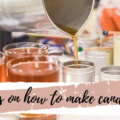Adding fragrances and scents in candles is one tricky process that needs years of experience to master. The scent throw of candles, specifically the hot throw, also varies depending on the fragrance used and other ingredients used in making the candles. Now, let us tackle this tricky process of assuring a strong hot throw for your candles and all the dos and don’ts to follow to achieve the optimum scent.
- 1. Choose the Appropriate Type of Wax
- 2. Know the Fragrance Notes of Your Scents
- 3. Use Enough Amount of Fragrance on Your Candle
- 4. Add the Fragrance Oil to the Wax at the Correct Temperature
- 5. Use Additives to Retain Higher Fragrance Loads
- 6. Choose the Right Type and Size of Wick
- 7. Allow Appropriate Curing Time for Your Candles
- 8. Use a Larger Container with More Wicks
- 9. Store Candles Away from Heat and Light
- 10. Place a Lid on Your Candles
- 11. Be Mindful with Adding Candle Colorants
- 12. Do Not Light the Candles in a Room Too Big
- Conclusion
1. Choose the Appropriate Type of Wax
All candle making waxes have their pros and cons when it comes to burning time, efficiency, as well as scent throw. There are candle waxes that hold more fragrance loads than others. In this case, we are talking about paraffin wax.
One effective way to make the most out of your scented candles is using paraffin wax. As fragrance oils perform differently according to the type of wax used, you’ll ensure a better scent throw, hot and cold, with paraffin wax.
Paraffin is known to accept and blend well with candle colorants and scents, while some waxes, like soy wax, can be the picky ones when it comes to fragrances.
Incorporating fragrance oils in candles is hard work to do as it requires a lot of trial and error on the amounts and the scent strength you want for your candles. That is why many high street candle brands still choose paraffin wax over other waxes like soy or beeswax.
One good explanation why paraffin wax retains and releases scents well is its low melting point. As the wax melts, the heat from the flame vaporizes the liquid wax, diffusing the scents into the air. Since paraffin wax melts easily, the fragrance will also be dispersed quickly into the air when the candle is lit.
2. Know the Fragrance Notes of Your Scents
It is important to note that not all fragrance oils are produced with a strong or overpowering smell. Some are just subtle scents, which you can consider to have poor scent throw. That is why it is essential to know your candle’s fragrance notes, rather than expecting every scented candle to be smelling powerful all the time.
Fragrance notes in candle making describe scents that you smell when you light a candle. These are grouped into three, namely the top or head notes, middle or heart notes, and base or dry notes. Each candle scent is created with a combination of the top, middle, and bottom notes.
Let us further discuss fragrance notes to guide you when choosing your scents. Top notes are the first scent you’ll smell in candles. They are typically fresh, light, and citrusy but don’t fade away fast. These are the smells you would typically experience when the candle is unlit.
Middle notes are the star of fragrance blends. They provide balance and harmony to enhance the top and bottom notes and come out at the early stage of candle burning. Popular middle notes are florals, spicy or herbaceous, and light fruits.
The bottom notes are the heavier and longer-lasting scents on your candles. They are often made of larger molecules and last the longest on all the fragrance notes, dominating the scent when the candle is burning.
It is essential to choose fragrances that have strong top, middle, and bottom notes if you want a strong hot throw.
3. Use Enough Amount of Fragrance on Your Candle
Using a small amount of fragrance oils on your candles would produce a weak scent throw. Hence, you may think that simply adding more fragrance oils to candles would ensure a strong hot throw, but that is not how candles work.
There are many considerations to look into since not all candle waxes accept the same amount of fragrances. Now, let us understand what we mean by using enough fragrances and how much is enough for each type of candle wax.
The amount of fragrance oils you should add depends on the wax used, the flashpoint of the fragrance oil, and the strength of the scent. Generally, most candle making waxes will hold no more than 12% fragrance oil. However, to ensure stability and balance to the candle, we recommend incorporating 10% of fragrance oils for optimal scent throw.
The percentage means that if your candle weighs 100 grams, 90 grams of it should be the wax and the 10 grams component is the fragrance oils.
Candles with a more subtle scent throw may only use 6% of fragrance oils, but the 10% amount would be best to ensure a strong hot throw.
Remember to use a well-working weighing scale to measure the amounts of fragrance oils and not just droppers or teaspoons. This ensures that the exact amount goes into your candle, as candle waxes are sensitive to excessive amounts of scents.
4. Add the Fragrance Oil to the Wax at the Correct Temperature
Knowing the appropriate wax temperature to add fragrance oils is key to achieving optimum hot throw. It’s because adding the scents at a higher temperature than required may cause them to burn off and disappear from the candle.
On the other hand, adding fragrance to candles at a lower temperature may prevent them from distributing and binding evenly with the wax. The effect is a candle with a poor scent throw or worse, fragrance oils pooling on top and bottom of the candle.
It is recommended to add your fragrance oil at 180-185 degrees Fahrenheit for soy and paraffin wax and 200-205 degrees Fahrenheit for palm wax, regardless of the fragrance’s flashpoint. This is the optimal temperature for the melted wax and fragrance to bind together, which will, in turn, provide the best hot throw for your candle.
Stir constantly for three to five minutes for the oil to distribute evenly to the melted wax.
5. Use Additives to Retain Higher Fragrance Loads
Additives can be incorporated into candles to enable the wax to retain higher fragrance loads, hence producing a strong hot throw. Many waxes on the market are even pre-blended with scent-enhancing additives to prolong candle scent.
Vybar is one known additive to improve the scent throw of your candles, be it cold or hot throw. It primarily aids in fragrance oil retention, increases candle opacity, and enhances candle dye colors.
Crisco shortening is a vegetable shortening added to paraffin wax for a better scent throw. This additive is best used in container waxes, blending one to two ounces of shortening per pound of paraffin wax used.
Suppose you are using essential oils on your paraffin scented candles. In that case, you may need to add polysorbate 80, a synthetic nonionic surfactant that prevents essential oils from settling at the bottom of your candle container, weakening the scent throw.
6. Choose the Right Type and Size of Wick
Using the appropriate wick size relative to your candle size is key to achieving optimum hot throw. As the wick is responsible for burning the wax, proper wick size would allow for the right amount of burn pool, which helps distribute fragrances in the air very well.
The wick size should just be enough to cover the full size of the candle when burning. Too small of a wick creates a small burn pool leading to poor scent throw. On the contrary, using a larger wick relative to the candle and container’s size may cause the candle to burn too hot, burning off the fragrance and resulting in a poor hot throw.
There are many types of candle wicks available in the market. Eco candle wicks are made from 100% cotton and paper fibers. They are self-trimming and burn cleanly and are perfect for soy pillars and tall container candles of up to seven inches high.
Another great choice for an excellent hot throw is the hemp candle wicks. These wicks are best used for beeswax pillars and container candles of up to 7 inches in height. They are made from 100% organic hemp.
7. Allow Appropriate Curing Time for Your Candles
Candle’s curing time is the actual number of hours it takes for the wax and fragrance oils to bind well with each other. This is crucial to ensure that the candle burns well and produces a strong scent throw.
A longer cure time is better for candles. The poured melted wax needs to harden first and the fragrance to settle throughout the whole candle. Burning the candle immediately without proper cure time will not lead to a strong hot throw.
Here is a guide you can consider in curing different types of candles. Soy candles take 10 to 14 days of curing, while paraffin takes shorter curing of three to five days. For blended waxes like parasoy, you can let it sit for seven to ten days before test burning. The same applies to beeswax and palm wax.
Coconut apricot wax may take a longer curing time of 14 days to ensure maximum hot throw for your candles.
8. Use a Larger Container with More Wicks
Multiple-wicked candles produce more scents than ordinary one-wicked candles. Using multiple wicks applies to larger candles and may benefit the scent throw and help make the candle burn evenly.
Having more wicks in one candle means multiple heat sources to melt your wax. In return, the fragrance would be quickly dispersed into the air, producing a stronger hot throw. However, the burn of these candles is quite faster than that of a single wick. Hence, the larger candle would not burn longer than expected.
Candles with multiple wicks are also great for balanced and evenly burning candles. These are great for filling a large room with fresh scents in the quickest way possible.
9. Store Candles Away from Heat and Light
Candles may expire over time like how food does. When candles expire, it only means that they lose their fragrance and become discolored. Temperature fluctuations and exposure to direct sunlight are two leading causes of candle deterioration, so you should always look into that.
It is highly recommended that you store candles in a cool and dark place, at room temperature. Direct exposure to sunlight and heat may melt the wax and cause the fragrances to dissipate from the candle.
Proper storing and caring for your candles will ensure that the scent throw it has the first time you light it will still be the same until it runs out. Furthermore, light your candles within 12 to 16 months of being bought, as this is the period where the fragrances are at their maximum.
10. Place a Lid on Your Candles
Most scented candles in the market come with a lid. This is not only for decoration purposes but is mainly for the candle’s protection and preservation. Without a lid, candles may collect dirt, dust, and grime. The scented additives may also dry up over time when not sealed properly.
Lids in candle containers prevent scents from evaporating. As the candle burns, the melted wax heats the essential oils and perfumes in the candle, evaporating into the air, producing a pleasant smell.
Without a lid, these fragrances may evaporate into the air even without lighting your candle. Luckily, only the top layers of the candle would be affected by this phenomenon. But just the same, you would need to wait for the top layer to melt before smelling your scented candles. So to prevent the scents from escaping your candles, you must secure them with a lid.
11. Be Mindful with Adding Candle Colorants
Candle colorants should be added in the right amount. When you put excessive colorants in your candles, you risk clogging your wick, which would affect the overall burning and scent throw of your candle.
Remember to use color dyes specifically manufactured for candle making. Never use pigments to color your wax. These should only be used for dipping the exterior of candles.
12. Do Not Light the Candles in a Room Too Big
Keep the candle size and the room size in mind when lighting up candles in your house. Larger candles with wider diameters produce a stronger hot throw, while smaller candles in tins or jelly jars may have a weaker scent throw.
Place larger candles in wider spaces like living rooms or on the patio to maximize the fragrances. A small candle would be enough for smaller spaces like bedrooms and kitchens.
Here is an article you can read to help you improve the overall scent throw of your candles, both hot and cold throw. This article provides you with all the tips and tricks you need in producing fragrant scented candles.
Conclusion
Fragrances are always great for candles. These tips would surely guide you to produce well-burning and awesome-smelling candles for your home or gifting. You should always remember that improving the scent doesn’t always mean adding excessive amounts. You may need to try and experiment with amounts and ingredients before coming up with your best scent.















